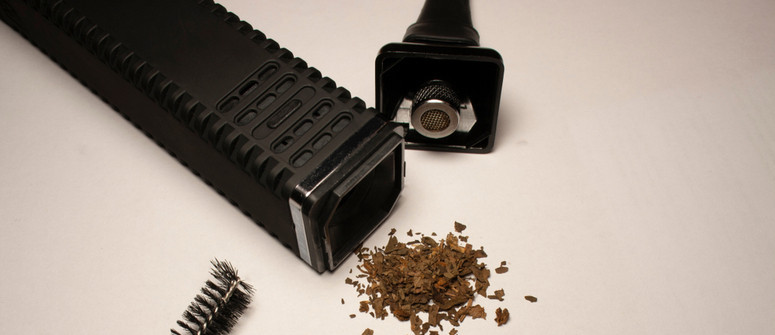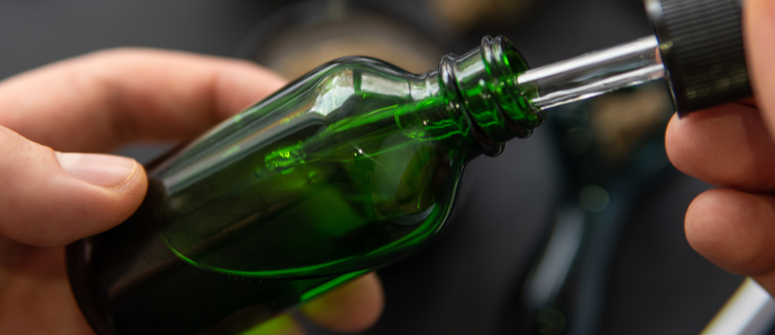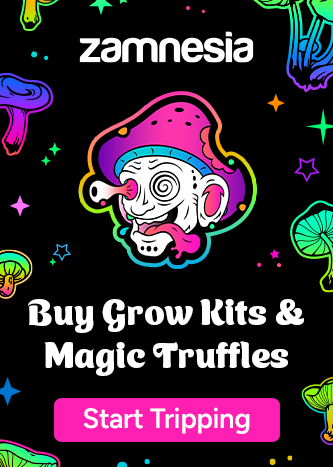How to transform vaped weed into cannabis oil

Don't throw out your vaped bud just yet; you can still enjoy what's left of the cannabinoids by creating cannabis oil. This article will serve as a step-by-step guide to making cannabis oil using AVB.
Contents:
So, you’ve gone through a good chunk of your beloved cannabis stash using your dry herb vaporizer. As you take the remaining plant matter out of the chamber, you notice it’s withered and brownish in colour. The bud looks more like pencil shavings now, devoid of that dank texture and distinct pungent aroma.
Your first instinct at this point might be to dispose of it, thinking it no longer has any purpose. But don’t throw it out just yet! You can still make good use of your already vaped bud (AVB) by turning it into cannabis oil.
In this article, we’ll delve into that process, review the benefits of cannabis oil, and provide some tips on proper storage. After reading this, you should be well-informed on how to repurpose that already vaped stash.
What Is AVB (Already Vaped Bud)?
As the name suggests, already vaped bud is the bud you previously used in a dry herb vaporizer. Ideally, this plant matter is exposed to temperatures less than 190°C (375°F).
If the herb is darker, almost black in colour, that means it was overheated. As a result, these burned up remnants have no other place but inside the trash bin.
What’s the Difference Between Already Vaped Buds and Fresh Buds?
The difference between already vaped bud and fresh bud lies chiefly in potency. The latter obviously delivers a much stronger hit, but that doesn’t mean you should declare your AVB dead just yet. Unlike smoking, the THC and CBD in AVB aren’t fully burned off. That means you can still get high off of them.
Now, you may ask, “Is AVB still smokable?”
Technically, yes, it is. But you’ll also have to endure a rough, extra smoky experience when you light it up, and the taste of the stale bong water will linger in your mouth. In short, don’t expect it to be a meaningful, or even pleasant, experience.
What to Do With Already Vaped Weed?
There are many ways you could make use of your AVBs, and edibles are a great option. Dried up buds are great for cooking because they no longer have that strong flavour that may interfere with the existing flavours of your recipe. The same notion applies to cannabis-infused drinks like tea or coffee.
Moreover, you no longer have to go through the decarboxylation process before ingesting, since your vaporizer already did that for you.
But if you don’t want to directly infuse cannabis into your food, you can go the always trusty cannabutter route. AVBs are a great add-on because they break down a lot easier, and you’ll need smaller pieces for your magic butter anyway. Now you have the perfect ingredient for any delicacy of your choice, whether it’s space cakes or pot pies (pun intended).

What Are the Benefits of Cannabis Oil?
• High concentration of THC
• Quick onset
• Discreet and easy to dose
• Easy to make and store
• Great way to use AVB
Cannabis oil is an extract derived from THC-enriched weed strains. It is highly psychotropic, and that also means it is illegal to consume in some parts of the world.
While some sectors of society demonise THC for the high it brings on, others are well-aware of the benefits it can offer all types of users. Some individuals utilise the holistic qualities of THC, such as to settle the stomach and ease tension, whereas others simply enjoy the relaxation and euphoria the cannabinoid can bring.
In itself, cannabis oil is convenient, discreet, and easy to dose. Rather than needing to smoke an entire joint or wait an hour for edibles to kick in, one can simply drop cannabis oil under the tongue for a fast onset of effects.
Cannabis oil is also easier to store, and can last quite a while if the right measures are taken. Plus, you can make cannabis oil from AVB—no need to waste your prime stash.
How Is Cannabis Oil Different From CBD Oil?
Let’s get one thing clear: cannabis oil is not the same as CBD oil. Whereas the former is derived from marijuana and contains a high THC content, the latter is most often derived from industrial hemp and goes through further processing to remove excess THC.
Because THC and CBD interact with the body’s endocannabinoid system differently, cannabis oil causes the characteristic high cannabis is known for, while CBD produces more subtle, non-psychotropic effects. In fact, it can actually balance out some of the mind-altering effects that THC induces, making the “stoned” experience more manageable.
How to Transform Already Vaped Weed Into Cannabis Oil
Now, let’s get to the meat of the matter. There are three ways to transform already vaped weed into cannabis oil: using a slow cooker, a stovetop, and an extraction machine.
Before anything else, you’ll need to pick a carrier oil. This will act as the primary solvent that will dissolve the cannabis compounds for easier absorption. As for which oil to go with, you can choose between MCT oil, avocado oil, grape seed oil, almond oil, or coconut oil, just to name a few.
How to Make Cannabis Oil With a Slow Cooker
Any functioning kitchen has a slow cooker, and using one isn’t complicated. For these reasons, this method is the most affordable and straightforward one on this list. The best part is, it only requires three simple steps.
Ingredients
AVB
Preferred carrier oil
Hardware
Fine mesh strainer
Cheesecloth
Measuring cup
Slow cooker
Stove
Directions
1. Add the oil and already vaped bud into the slow cooker.
2. Place the slow cooker on the stove over low heat, and let the mixture cook for 4–8 hours. This promotes extraction of the cannabinoids from the herb.
3. Place the strainer on top of the measuring cup, and the cheesecloth on the strainer. Pour your oil mixture into the cup. If you do it right, your cheesecloth and strainer should catch the AVB and effectively separate the oil.
Some folks choose to let the mixture cook way longer. However, the eight-hour timeframe is sufficient enough to complete the extraction process, so it’d be best to stick with it and avoid wasting resources.
How to Make Cannabis Oil on a Stovetop
If you don’t have a slow cooker at home, this is the next best way to make yourself some cannabis oil. Instead of a crockpot, you’ll be using a Dutch oven.
Ingredients
AVB
Preferred carrier oil
Hardware
Dutch oven
Oven-safe glass jar
Stove
Fine mesh strainer
Cheesecloth
Measuring cup
Directions
1. In a tall, clear jar, place the buds and the oil. Mix well.
2. Place the jar into the Dutch oven filled with 2–3 cups of water. Then, place the oven onto the stove over medium-high heat to let the simmering process begin. Bring to a boil.
3. Lower the heat and allow the oil to simmer for at least four hours. Check on it every 15–20 minutes and add more water when necessary to prevent the oil from burning.
4. Take your strainer and place it on the measuring cup. Place the cheesecloth over the strainer to act as a second filter. Pour your oil mixture into the cup, allowing your sifter to catch the plant matter.
How to Make Cannabis Oil With an Extraction Machine
If you want to go a little more advanced, an extraction machine is a good option. You can opt for one that operates on electricity, but if you want to do a little exercise, manual machines are available as well.
There are many machines available on the market, and all you’ll need to do is to pick the one most suitable for you. They work very efficiently, and the waiting time isn’t that long. The main benefit of these machines is the purity and safety of the end product.
One disadvantage, however, is that they operate at a very low capacity. It shouldn’t be a problem if you’re whipping up a solo batch, but if you want to scale it up a bit, go with either the stovetop or slow cooker methods.
How to Store Cannabis Oil
• Keep cannabis oil in a cool, dry, dark place (e.g. refrigerator or cupboard)
Now, let’s talk about storage. One thing to keep in mind is that prolonged exposure to light, oxygen, or heat may compromise the quality of your final product. So, your safest bet would be to store your oil in a cool, dry place away from direct sunlight. If you want more control in terms of temperature, you may want to consider refrigeration.
When it comes to long-term storage, alcohol tinctures are the way to go. If sealed and refrigerated, they can last for an indefinite amount of time. Talk about saving up for a rainy day. But even regular cannabis oil should last as long as the oil carrier itself (around two years under ideal conditions).
Is It a Good Idea to Turn Vaped Weed Into Cannabis Oil?
AVB may not be as potent as fresh buds, but concentrating it into an extract enhances the potency significantly. While smoking AVB can be downright unenjoyable, turning it into cannabis oil will have you forgetting that you started off with lower-grade plant material.
Then again, if you’re not a fan of oils, you can also render your AVB into edibles, capsules, or cannabutter. It’s just a matter of making the choice that’ll suit you best—and that’s a good problem to have.




